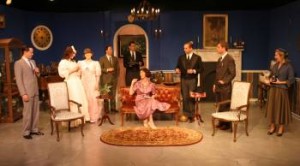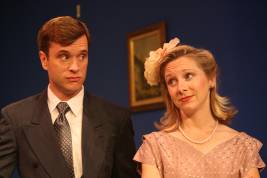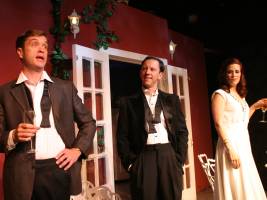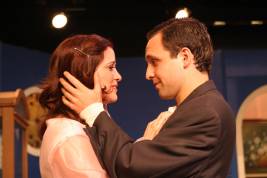
Fans of 1930s comedies will want to cheer Actors Co-op’s revival of Philip Barry’s 1939 hit The Philadelphia Story, a title quickly recognized by film buffs as that of the Oscar-winning 1940 movie classic starring Cary Grant, Katharine Hepburn, and James Stewart. (Hepburn starred in both stage and screen versions, with the plot of the MGM adaptation sticking much closer to the Broadway original than did, say, the movie versions of You Can’t Take It With You or Stage Door.)
Hepburn was—and now Tara Battani is—Tracy Lord, beautiful, sophisticated, wealthy, witty, and divorced, the latter hardly a big deal in 2010 but a good deal more so in 1939. Despite the bittersweet taste left in her mouth by her 10-month marriage to the equally blue-blooded C.K. Dexter Haven (Marcos Esteves), Tracy has gotten herself engaged to self-made millionaire George Kittredge (Daniel J. Roberts), the wedding to take place just a day from now.
Tracy’s father Seth happens to be rather a bit of a philanderer, his dalliance with the never seen dancer Tara Maine having contributed to his own failure at wedded bliss. Thus, when Destiny (the 1939 equivalent of The National Enquirer) threatens an exposé of Seth’s shenanigans, Tracy’s happily married brother Sandy (Gary Clemmer) brokers a deal. Destiny will quash the story of the Seth Lord/Tara Maine scandal in exchange for exclusive rights to behind-the-scenes coverage of Tracy’s wedding preparations and the ceremony itself.
Reporter Macaulay “Mike” Connor (Stephen Van Dorn) and his Girl Friday photographer Liz Imbrie (Tannis Hanson) arrive at the Lord estate, soon followed by none other than C.K. Dexter Haven, summoned by Tracy’s kid sister Dinah (Alison Freeman) to throw a wrench into his ex’s wedding plans.
In typical romantic comedy fashion, Tracy suddenly finds herself pursued by three handsome, eligible young men, each as attractive and eligible as the next. Unlike most romcoms, however, just who Tracy ends up remains open to question until only minutes before the final curtain, and you won’t find this review giving away the ending except to say that it’s a satisfying one indeed.
That’s not to say that Barry’s play is perfect. A deliciously screwball first act and an equally delightful third are interrupted by a second act that plays out mostly as one-on-one scenes that tend to drag on too long (they did in the movie as well). If Barry were still around, I’d suggest a 20-minute trim. As is, it takes the bubbly, unpredictable third act to get things bouncing again.
Key to the success of any 1930s revival is an awareness and understanding of the era’s style. To perform Barry (or George Kaufman or Moss Hart) with the contemporary voice or mannerisms of Neil Simon would prove incongruous at best and disastrous at worst. Director Douglas Clayton, doing tip-top work as always, clearly understands this and in fact had his cast “dress up” for rehearsals. Accent coach Freeman worked with the company on “mid-Atlantic” pronunciation, and movement coach Heather Corwin made sure that there would be no slouching, or crossed legs by women of a certain age. Though there is occasional “slippage,” and though the pace could be picked up even a tad more, the cast pass their High Society Exams with flying colors.
The gorgeous Battani makes a memorable Co-op mainstage debut as Tracy, recalling the spirited elegance of Katharine Hepburn without ever imitating the stage and screen legend. Van Dorn, Esteves, and Roberts (three ever so handsome Co-op gems) are all terrific as the men vying for Tracy’s love, so much so that her decision does seem a tough one, at least until one of them reveals a priggish side, leaving Tracy with a heads-or-tails choice.
Supporting performances are every bit as fine as the leads’. Clemmer effectively erases memories of his countrified roles with an excellent, sophisticated turn as Sandy. As Liz, Hanson does her best work in her best Co-op role yet as the kind of gal pal that earned Eve Arden and Ruth Hussey (the movie’s Liz) long, successful Hollywood careers. Greg Martin (Seth) and Susan Carol Davis (Margaret) are absolutely believable as wealthy Philadelphia Mainliners, and Steve Gustafson has a delightful turn as dandy Uncle Willie. Tim Farmer does well in brief scenes as night watchman Mac and Dr. Parsons, as do Brandon Massey and James Runcorn and as Lord family servants. The one casting misstep is Freeman as Dinah. There’s nothing wrong with the actress’s appropriately precocious performance, but she’s simply too old for a role written for a girl Barry describes “all of thirteen.” Played by an actress who looks eighteen at the very youngest, adorable can cross too easily over into insufferable.
Scenic designer David Mauer has created an elegant Lord family sitting room (painstakingly dressed by prop designer Lori Berg) whose walls unfold at intermission to transform the set into the porch outside the Lord mansion, and then back again for Act Three. James L. Moody’s lighting design is an effective one, though a bit too dim for audience alertness in the moonlit second act scenes. Sound designer Alan Falkner gets high marks, punctuating Act Two scenes with romantic late night sounds. Kimberly Overton’s costumes have a suitably elegant 1930s look. Hairstyles are a fair approximation of the era, with Davis’s wig the most accurate choice. Rita Cofield is assistant director, Jessica CalCanton dramaturg, and Laura A. Hovermale production stage manager. The Philadelphia Story is produced by Rebecca Hayes.
All in all, The Philadelphia Story makes for a smashing end to the Co-op’s 2009-10 season. Family friendly enough to please conservative theater (and church) goers yet sophisticated enough to bring in more liberal audiences, it is a gem of a play and production.
Actors Co-op, 1760 N. Gower St., Hollywood.
www.actorsco-op.org
–Steven Stanley
May 2, 2010
Photos: Lindsay Schnebly






 Since 2007, Steven Stanley's StageSceneLA.com has spotlighted the best in Southern California theater via reviews, interviews, and its annual StageSceneLA Scenies.
Since 2007, Steven Stanley's StageSceneLA.com has spotlighted the best in Southern California theater via reviews, interviews, and its annual StageSceneLA Scenies.







 COPYRIGHT 2024 STEVEN STANLEY :: DESIGN BY
COPYRIGHT 2024 STEVEN STANLEY :: DESIGN BY